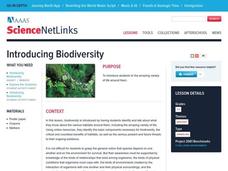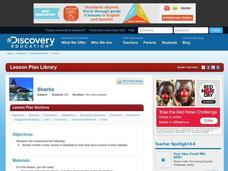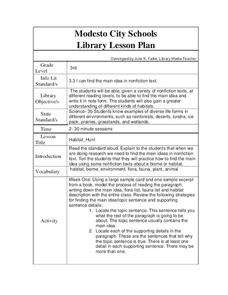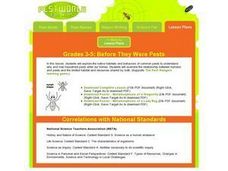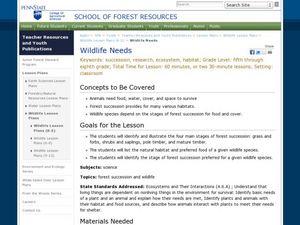Curated OER
The Importance of Trees in the Rural Area: Planting a Snowfence
Students discuss the importance of trees and work together to plant a living snowfence. In this tree importance lesson, students discuss why trees are important in rural areas. They use mathematics and team work to plant a living snowfence.
Curated OER
The Giant Pandas
Young scholars recognize that pandas are endangered. In this panda lesson plan, students research and create a pamphlet about pandas. Young scholars create a 30 second advertisement. Students participate in problem solving for...
Curated OER
Food Chains and Food Webs
Fourth graders investigate food chains. For this living environment lesson, 4th graders begin to understand the interdependence of organisms. Students describe the connections organisms have to the ecosystem. Students research online,...
Curated OER
Habits: An Introduction
Second graders identify different types of habitats animals live in to have a better understanding of the world around them. They choose a habitat, draw a picture of an animal that lives there and list the unique attributes the habitat...
Curated OER
Introducing Biodiversity
Students are introduced to the life around them. As a class, they discuss their prior knowledge about the habitats in their local area. Using the internet, they identify the basic components needed for biodiversity and the major...
Curated OER
Habitat Collage
Students explore habitats. In this science lesson, students discuss habitats and the insects that are found within each habitat. Students create a habitat collage.
Curated OER
Visiting Museums
Learners visit museums and gather information about dinosaur habitats, survival needs, and how they met these needs.
Curated OER
Animal Adaptations
Students will participate in classroom discussions and visit a website to learn more about animals and how well (or poorly) they've adapted to satisfying their needs in their natural habitats. This will help move them toward the goal, in...
Curated OER
She Sells Sea Shells in Illinois??
Second graders sorted shells first by methods they thought appropriate and then were instructed on the scientific method of classification by univalve and bivalve. Students then sorted paper shells as a method of assessing knowledge. It...
Curated OER
Investigating Local Ecosystems
Students investigate the habitats of local plants and animals. They explore some of the ways animals depend on plants and each other. Students observe living organisms in a local ecosystem and create detailed drawings and descriptions...
Curated OER
Sharks
Students create a model or drawing of a shark species showing its specific adaptations. In small groups, they research the shark species on the internet looking for adaptations of teeth, body shape, coloration and fins. There is a...
Curated OER
Getting to Know Some of Pennsylvania's Fishes
Students research and identify the fish of Pennsylvania. In this earth science lesson, students view ten photos of fish and identify the characteristics of each fish. Students record observations and practice naming the fish using their...
Curated OER
Habitat Hunt
Third graders read several nonfiction texts and practice finding the main idea for the text as well as learn about various habitats. In this main idea lesson, 3rd graders read several nonfiction texts and make habitat cards. Students...
Curated OER
Pet Overpopulation
Students identify ways animal shelters prevent pet overpopulation. In this animal welfare instructional activity, students review facts about pet overpopulation and consult a phone directory for animal welfare listings. Students call and...
Curated OER
Trout Markings
Young scholars paint a trout based on the pictures of trout coloration and markings they see in pictures. In this trout lesson plan, students understand that the markings on a trout are native to their habitats and create camouflage.
Curated OER
Is It Alive?
First graders explore living things and their habitats. They create an original It's Alive! book to demonstrate what they have learned.
Curated OER
Before They Were Pests
Young scholars explore the native habitats and behaviors of common pests to explain why and how household pests enter our homes. Theyexamine the relationship between humans and pests and the limited habitat and resources shared by both.
Curated OER
Wildlife Needs
Young scholars identify the wildlife needs in a specific setting. In this wildlife needs instructional activity, students identify and illustrate the four stages of forest succession. Young scholars list the natural habitat and food for...
Curated OER
Endangered Species of PA
High schoolers research and publish information about an endangered species on the school's web site. For this endangered species lesson, students choose an at-risk species to research. They publish their research information on the...
Curated OER
Protect the Bats!
Young scholars explore bat habitats. In this bat lesson, students discover the work of people trying to protect bat habitats. Young scholars make posters that promote the message of saving bats.
Curated OER
Cypress/Tupelo Swamps
Students study the geologic history of terrain, soils, and drainage patterns. They recognize ecological processes that determine the dynamic nature of habitats. They investigate the influence of human activity on the landscape.
Curated OER
Leaf Pack Study
Young scholars conduct an experiment using leaf packs. In this leaf lesson plan students complete an activity in groups and complete a handout.
Curated OER
Rx Rainforest:
Students identify plant diversity in the rainforest and the role that animals and habitats play in scientific research. They differentiate between natural habitat and laboratory research and work collaboratively to produce a video news...
Curated OER
Pet Overpopulation
Students identify the needs of animals. In this animal welfare lesson, students read the article "If This Cat Could Wish" and identify the needs of animals. Students color in a coloring sheet of a cat.






